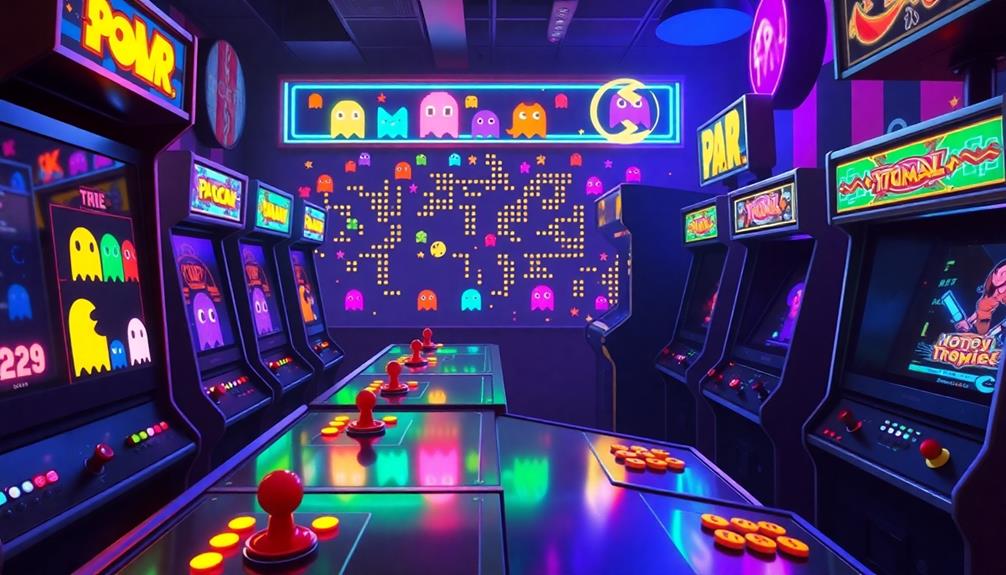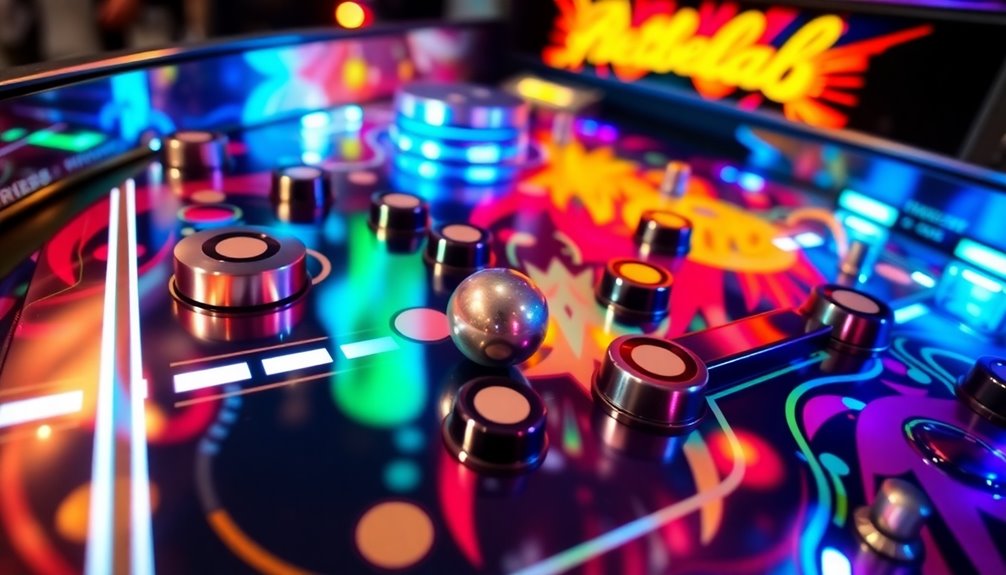Pac-Man is a timeless classic arcade game that has been entertaining fans since its launch in 1980. Players navigate through mazes, gobbling up dots and outsmarting colorful ghosts to earn points. Each ghost has its own unique strategy, creating a thrilling and one-of-a-kind gaming experience every time. With numerous sequels and adaptations, Pac-Man has stayed relevant by introducing new challenges and modern graphics. The game’s classic charm is kept alive in communities where players share tips and stories. Whether you’re a retro enthusiast or a newcomer, Pac-Man offers endless entertainment, with a fascinating legacy and lasting impact on gaming culture waiting to be explored. Fans can look forward to the excitement of the upcoming Arcade1up pinball release, which promises to add a fresh twist to the beloved game. As the legacy of Pac-Man continues to evolve, it’s evident that this iconic game will keep captivating players for years to come.
Fans of Pac-Man can anticipate more excitement with the upcoming Arcade1up pinball release date. This new addition to the Pac-Man universe will surely bring a fresh twist to the classic game, and enthusiasts are eagerly awaiting its arrival. As the Pac-Man legacy continues to evolve, it’s clear that this beloved game will continue to captivate players for generations to come.
Key Takeaways
- Pac-Man, released in 1980, revolutionized gaming with its non-violent protagonist and appeal to a broad audience, including women.
- The game's unique ghost behaviors and scoring system create engaging and challenging gameplay that remains captivating across generations.
- Over 35 sequels and adaptations, such as Ms. Pac-Man and mobile versions, keep the Pac-Man legacy alive and relevant.
- A vibrant community of collectors and players fosters nostalgia and ongoing engagement through forums, challenges, and vintage arcade restoration.
- Modern advancements in graphics and gameplay mechanics have ensured Pac-Man's timeless appeal in the gaming world.
The History of Pac-Man

Pac-Man, a game that's captured hearts and minds since its inception, was first released in Japan on May 22, 1980. Developed by Namco and conceived by Toru Iwatani, the game aimed to attract a broad audience, including women, which was quite innovative for its time.
By July 1980, it became a cultural phenomenon, enchanting players with its unique gameplay and vibrant characters.
Licensed to Bally Midway for the U.S. market, Pac-Man hit American arcades on October 26, 1980. This marked a significant moment in video game history, as it introduced the first non-violent protagonist in a gaming landscape dominated by aggressive themes.
Players navigated mazes, gobbling pellets while avoiding the colorful Ghost Monsters—Blinky, Pinky, Inky, and Clyde—each with distinct behaviors that added depth to the gameplay.
Pac-Man didn't just stop at arcade cabinets; it spawned a successful media franchise, leading to sequels, merchandise, and adaptations.
This enduring legacy solidified Pac-Man's place in video game history, making it a beloved classic that continues to resonate with new generations of gamers.
Gameplay Mechanics Explained

In this iconic action maze chase game, your main goal is to consume all 240 dots and 4 Energizers while skillfully avoiding the four Ghost Monsters. Each ghost has unique targeting behaviors that add depth to the gameplay mechanics. For example, Blinky, the fastest ghost, relentlessly chases you, while Pinky tries to cut you off from the front. Steering through the maze requires quick thinking and strategic movement.
When you eat an Energizer, the gameplay shifts dramatically. The Ghost Monsters turn vulnerable, giving you the chance to gobble them up for bonus points, starting at 200 per ghost. As you progress, bonus items appear after consuming specific dots, with their point values increasing, heightening the challenge.
Additionally, Warp Tunnels serve as vital escape routes, allowing you to evade the ghosts by emerging on the opposite side of the maze. This mechanic is key to mastering the game, especially in higher levels.
If you're a fan of classic video games, you'll appreciate how these gameplay mechanics keep the experience engaging and exciting. In later versions like Super Pac-Man, the core elements remain, ensuring the thrill of the chase never gets old!
Iconic Characters and Their Roles

The characters in Pac-Man play vital roles that enhance the overall experience of the game. As you navigate through the maze, you take on the role of Pac-Man, whose goal is to consume all 240 dots while skillfully avoiding four iconic characters—the Ghost Monsters.
Each ghost presents a unique challenge. Blinky, the red ghost, is the fastest and relentlessly chases you, making your strategic movements essential. Then there's Pinky, the pink ghost, who aims to cut you off, adding an unpredictable twist to your escape plan.
Inky, the cyan ghost, behaves differently; his movements depend on both your position and Blinky's, making him a wildcard in the game. Finally, Clyde, the orange ghost, starts by targeting you but retreats when you get too close, offering an interesting dynamic.
These iconic characters not only look great but also contribute greatly to the gameplay, turning a simple maze into a thrilling chase. They keep you on your toes, ensuring that Pac-Man remains one of the most beloved video games. Each encounter with them adds excitement and keeps you coming back for more!
Scoring System Breakdown
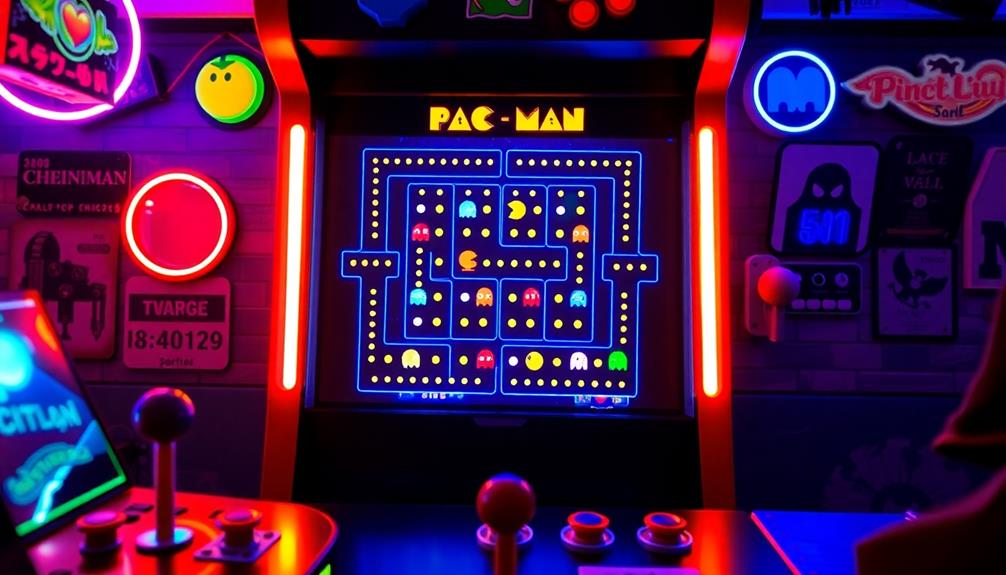
A clear understanding of the scoring system in Pac-Man is essential for maximizing your gameplay experience. By knowing how to rack up points effectively, you can enjoy the game and push your scores higher than the last time you played.
Here's a breakdown of the key scoring elements:
| Action | Points Awarded |
|---|---|
| Eating a dot | 10 points |
| Eating an Energizer | 50 points |
| First Ghost (while scared) | 200 points |
| Bonus items (starting) | 100 points |
As you advance through the rounds, scoring points becomes more challenging. The ghosts get faster, and after round 21, Energizers lose their effectiveness, making it tougher to maximize your score against them. Furthermore, bonus items increase in value as you progress, reaching up to 5,000 points for certain fruits.
Evolution of Pac-Man Games

As you explore the evolution of Pac-Man games, you'll notice how game mechanics have transformed over the years, introducing fresh challenges and strategies.
You'll also see the franchise expand into various media, reflecting its cultural impact and technological advancements.
This journey highlights not just the gameplay changes, but how Pac-Man continues to resonate with gamers today.
Game Mechanics Evolution
Evolving gameplay mechanics have kept the Pac-Man franchise fresh and engaging for decades. You can trace the origins back to the original 1980 release, which introduced innovative maze chase mechanics. As you navigate the maze, consuming dots while avoiding Ghost Monsters, you'll see how this foundational gameplay has paved the way for future adaptations.
With titles like Pac-Man Championship Edition, new elements emerged, such as time-limited challenges and speed boosts, which kept things exciting for players. If you've got a knack for strategy, you'll appreciate the introduction of power-ups, providing unique abilities and temporary invincibility, allowing for smarter navigation through the maze.
The mobile adaptation also modernized the experience, incorporating themed events and exclusive skins that cater to today's gaming trends while still retaining the classic arcade essence.
As you immerse yourself in newer games, you'll notice the scoring system has evolved too, with increased point values for more challenging tasks.
These mechanics guarantee that even after all these years, you can still play Pac-Man and find it pretty good—each new iteration keeps the thrill alive, proving that the franchise truly never gets old!
Franchise Expansion Timeline
Tracking the expansion of the Pac-Man franchise reveals a rich history of innovation and adaptation that began with its debut in 1980.
Initially launched in Japanese arcades on May 22, it quickly made its way to the U.S. on October 26, thanks to Bally Midway. The game's instant success paved the way for sequels, with Ms. Pac-Man hitting the scene in 1981 and becoming one of the most beloved arcade games ever.
As the years rolled on, the franchise expanded into over 35 games, including popular titles like Pac-Man World and Pac-Man 256.
These adaptations kept the core essence of the original while introducing new mechanics and challenges. Beyond gaming, Pac-Man's influence stretched into various media formats, including animated TV shows and an array of merchandise, which helped cement its place in pop culture.
Technological Advancements Impact
The evolution of Pac-Man games has been considerably shaped by technological advancements over the years. When you look back at the original Pac-Man from 1980, it utilized simple 8-bit graphics that set the standard for arcade games. Fast forward to today, and you'll see how modern graphics, new obstacles, and unique power-ups have enhanced gameplay for contemporary audiences.
The introduction of themed events and exclusive skins in newer versions, like Adventure Mode, reflects significant advancements in game design and user engagement. With mobile gaming on the rise, you can play Pac-Man on various platforms, ensuring it remains relevant. The game's compatibility with devices like iPhone, iPad, and Mac with the Apple M1 chip makes it accessible to everyone.
Here's a visual representation of this evolution:
| Year | Key Advancement | Impact |
|---|---|---|
| 1980 | 8-bit graphics | Set arcade standards |
| 2005 | Mobile version | Expanded accessibility |
| 2010 | Adventure Mode | Introduced new gameplay elements |
| 2015 | Multi-device compatibility | Broadened player base |
| 2023 | In-app purchases & ratings | Maintained relevance and user engagement |
Community Engagement and Culture
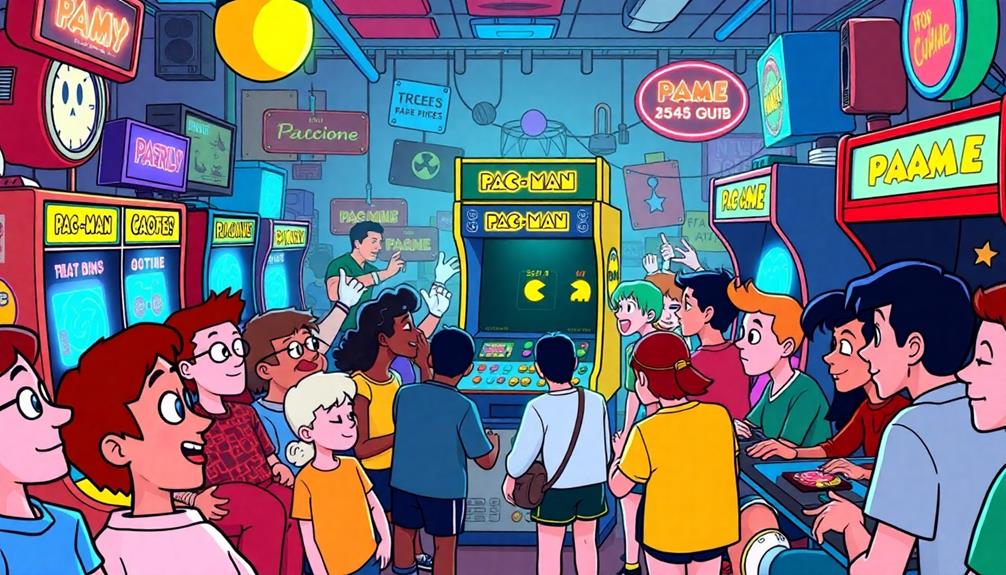
Pac-Man isn't just a game; it's a vibrant community that thrives on shared experiences and nostalgia.
You'll find countless online forums and social media platforms buzzing with enthusiasts enthusiastic to share their gameplay experiences and restoration tips. These spaces are alive with discussions about the emotional connections many players have with the game, reflecting how deeply it resonates across generations.
Community engagement shines through various events and challenges, like the weekly maze challenges in the mobile version.
These activities foster both competition and collaboration, drawing players together in their quest for high scores. If you're a collector of vintage arcade machines, you may join dedicated groups where you can exchange insights about restoration and celebrate the stories behind each piece of your collection.
The enduring popularity of Pac-Man has sparked discussions about potential remakes and adaptations by modern manufacturers, highlighting the ongoing interest within the gaming community.
Articles and forum threads about Pac-Man attract thousands of views and comments, showcasing its significant cultural impact and the lively community that continues to celebrate this arcade classic.
Whether you're a gamer or a collector, you're part of something special.
The Legacy of Pac-Man
Since its launch in 1980, Pac-Man has carved out an indelible legacy in the gaming world. Developed by Namco, it quickly became a cultural phenomenon, spawning a variety of sequels, merchandise, and adaptations. This game set new standards in action gaming with its innovative maze chase format and unique ghost behaviors, influencing countless titles that followed.
The character of Pac-Man has made numerous appearances in various media, from television shows to films. Its iconic design and gameplay have solidified its place in pop culture. Even today, Pac-Man remains relevant, with modern adaptations and mobile versions keeping the spirit alive for new generations of players.
Here's a quick look at some key aspects of Pac-Man's legacy:
| Year | Milestone | Impact |
|---|---|---|
| 1980 | Launch in Japan | Revolutionized arcade gaming |
| 1982 | Merchandise boom | Expanded cultural footprint |
| 2023 | Mobile adaptations | Introduced to new players |
Pac-Man's legacy is a reflection of its enduring appeal, proving that some classics never truly fade away.
Nostalgia and Collecting Arcade Games
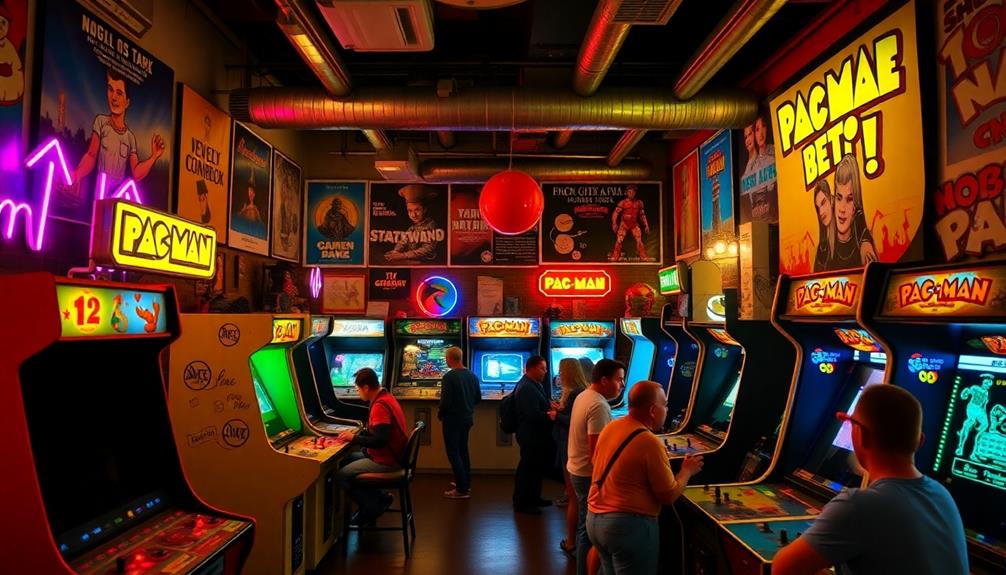
Nostalgia for classic arcade games like Pac-Man has ignited a passionate movement among collectors, many of whom seek to reclaim the joy of their youth. You might find vintage machines selling for varying prices on platforms like eBay, with some listings going for what feels like "pennies."
The emotional connections formed around these machines are profound, as collectors often share personal stories of long-term ownership and the thrill of integrating iconic games like Baby Pac-Man into their personal spaces.
The rarity and unique mechanics of these games fuel their desirability, driving the vintage arcade market's growth and increasing demand for restoration efforts. Engaging with online forums and discussions dedicated to arcade and pinball machines, you'll see articles that garner thousands of views, highlighting the shared nostalgia within this community.
When it comes to restoration, collectors prioritize maintaining the original aesthetics of their machines, ensuring that the nostalgic value isn't lost while tackling the technical challenges of aging equipment.
This dedication not only preserves history but also creates a tangible connection to the past, allowing you to relive those cherished memories every time you play.
Modern Adaptations and Availability

The enduring charm of classic arcade games like Pac-Man has inspired developers to create modern adaptations that cater to both new players and longtime fans. The PAC-MAN mobile game, developed by BANDAI NAMCO Entertainment America Inc., brings the classic arcade experience right to your fingertips. With its intuitive controls and nostalgic gameplay, the mobile adaptation captures the essence of the original while introducing fresh challenges and features. For those who still cherish the retro vibe, the iconic ms pacman arcade machine remains a cherished centerpiece in game rooms and arcades worldwide. These adaptations and classic machines alike ensure that Pac-Man’s legacy continues to thrive across generations.
With features like Classic 8-Bit Arcade Mode and an engaging Story Mode, you can enjoy the nostalgia while discovering new adventures. This game is available for free on various platforms, making it accessible to everyone.
You can opt for in-app purchases to buy tokens or remove ads, but you can still have a great experience without spending a dime. Limited-time themed events and exclusive skins in Adventure Mode keep the content fresh, ensuring that you won't get bored.
Moreover, you'll find weekly maze challenges and three difficulty modes, catering to both casual players and hardcore fans alike. The game's impressive overall rating of 4.4 out of 5 stars from over 65,000 ratings reflects its lasting appeal in the gaming community.
With these modern adaptations, Pac-Man continues to thrive, inviting everyone to join the fun.
Frequently Asked Questions
What Is the Oldest Pac-Man Game?
The oldest Pac-Man game is the original arcade version, released in Japan on May 22, 1980. You'll find it revolutionized gaming, appealing to diverse audiences and becoming a cultural icon that's still cherished today.
How Old Is the Oldest Arcade Game?
Imagine stepping back in time; the oldest arcade game, "Tennis for Two," debuted in 1958. That makes it over 65 years old now. It's fascinating how gaming has evolved since those early days, isn't it?
Why Did the Original Pac-Man Game Glitch on Level 256?
The original Pac-Man game glitches on Level 256 due to an integer overflow error. When your score exceeds 255, the game can't process it, resulting in random characters filling the screen and blocking your progress.
How Do You Get God Mode on Pac-Man?
To access God Mode in Pac-Man, you've gotta exploit glitches or use specific controller sequences. Sometimes, reaching a particular score does the trick. Just remember, each version might have different methods to achieve invincibility!
Conclusion
Pac-Man isn't just a game; it's a cultural phenomenon that's captivated millions since its debut. Did you know that players around the world have collectively eaten an estimated 10 billion dots? That's enough to wrap around the Earth multiple times! Whether you're dodging ghosts or chasing high scores, Pac-Man's charm remains timeless. Its legacy continues to thrive, reminding us of the joy and nostalgia of arcade gaming. So grab a joystick and relive the magic!


